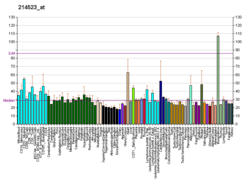CEBPE
CCAAT/enhancer binding protein (C/EBP), epsilon, also known as CEBPE and CRP1, is a type of ccaat-enhancer-binding protein. CEBPE is its human gene[3][4] and is pro-apoptotic.[5]
The protein encoded by this gene is a bZIP transcription factor which can bind as a homodimer to certain DNA regulatory regions. It can also form heterodimers with the related protein CEBP-δ. The encoded protein may be essential for terminal differentiation and functional maturation of committed granulocyte progenitor cells. Mutations in this gene have been associated with specific granule deficiency, a rare congenital disorder. Multiple variants of this gene have been described, but the full-length nature of only one has been determined.[3]
References
- ↑ "Human PubMed Reference:".
- ↑ "Mouse PubMed Reference:".
- 1 2 "Entrez Gene: CEBPE CCAAT/enhancer binding protein (C/EBP), epsilon".
- ↑ Antonson P, Stellan B, Yamanaka R, Xanthopoulos KG (Jul 1996). "A novel human CCAAT/enhancer binding protein gene, C/EBPepsilon, is expressed in cells of lymphoid and myeloid lineages and is localized on chromosome 14q11.2 close to the T-cell receptor alpha/delta locus". Genomics. 35 (1): 30–8. PMID 8661101. doi:10.1006/geno.1996.0319.
- ↑ Nakajima H, Watanabe N, Shibata F, Kitamura T, Ikeda Y, Handa M (May 2006). "N-terminal region of CCAAT/enhancer-binding protein epsilon is critical for cell cycle arrest, apoptosis, and functional maturation during myeloid differentiation". The Journal of Biological Chemistry. 281 (20): 14494–502. PMID 16531405. doi:10.1074/jbc.M600575200.
Further reading
- Sladek FM, Darnell JE (Apr 1992). "Mechanisms of liver-specific gene expression". Current Opinion in Genetics & Development. 2 (2): 256–9. PMID 1638120. doi:10.1016/S0959-437X(05)80282-5.
- Gombart AF, Koeffler HP (Jan 2002). "Neutrophil specific granule deficiency and mutations in the gene encoding transcription factor C/EBP(epsilon)". Current Opinion in Hematology. 9 (1): 36–42. PMID 11753076. doi:10.1097/00062752-200201000-00007.
- Williams SC, Cantwell CA, Johnson PF (Sep 1991). "A family of C/EBP-related proteins capable of forming covalently linked leucine zipper dimers in vitro". Genes & Development. 5 (9): 1553–67. PMID 1884998. doi:10.1101/gad.5.9.1553.
- Antonson P, Stellan B, Yamanaka R, Xanthopoulos KG (Jul 1996). "A novel human CCAAT/enhancer binding protein gene, C/EBPepsilon, is expressed in cells of lymphoid and myeloid lineages and is localized on chromosome 14q11.2 close to the T-cell receptor alpha/delta locus". Genomics. 35 (1): 30–8. PMID 8661101. doi:10.1006/geno.1996.0319.
- Chumakov AM, Grillier I, Chumakova E, Chih D, Slater J, Koeffler HP (Mar 1997). "Cloning of the novel human myeloid-cell-specific C/EBP-epsilon transcription factor". Molecular and Cellular Biology. 17 (3): 1375–86. PMC 231862
 . PMID 9032264. doi:10.1128/mcb.17.3.1375.
. PMID 9032264. doi:10.1128/mcb.17.3.1375. - Yamanaka R, Kim GD, Radomska HS, Lekstrom-Himes J, Smith LT, Antonson P, Tenen DG, Xanthopoulos KG (Jun 1997). "CCAAT/enhancer binding protein epsilon is preferentially up-regulated during granulocytic differentiation and its functional versatility is determined by alternative use of promoters and differential splicing". Proceedings of the National Academy of Sciences of the United States of America. 94 (12): 6462–7. PMC 21072
 . PMID 9177240. doi:10.1073/pnas.94.12.6462.
. PMID 9177240. doi:10.1073/pnas.94.12.6462. - Verbeek W, Gombart AF, Chumakov AM, Müller C, Friedman AD, Koeffler HP (May 1999). "C/EBPepsilon directly interacts with the DNA binding domain of c-myb and cooperatively activates transcription of myeloid promoters". Blood. 93 (10): 3327–37. PMID 10233885.
- Lekstrom-Himes JA, Dorman SE, Kopar P, Holland SM, Gallin JI (Jun 1999). "Neutrophil-specific granule deficiency results from a novel mutation with loss of function of the transcription factor CCAAT/enhancer binding protein epsilon". The Journal of Experimental Medicine. 189 (11): 1847–52. PMC 2193089
 . PMID 10359588. doi:10.1084/jem.189.11.1847.
. PMID 10359588. doi:10.1084/jem.189.11.1847. - Tavor S, Vuong PT, Park DJ, Gombart AF, Cohen AH, Koeffler HP (Mar 2002). "Macrophage functional maturation and cytokine production are impaired in C/EBP epsilon-deficient mice". Blood. 99 (5): 1794–801. PMID 11861297. doi:10.1182/blood.V99.5.1794.
- Zhang P, Nelson E, Radomska HS, Iwasaki-Arai J, Akashi K, Friedman AD, Tenen DG (Jun 2002). "Induction of granulocytic differentiation by 2 pathways". Blood. 99 (12): 4406–12. PMID 12036869. doi:10.1182/blood.V99.12.4406.
- Kim J, Cantwell CA, Johnson PF, Pfarr CM, Williams SC (Oct 2002). "Transcriptional activity of CCAAT/enhancer-binding proteins is controlled by a conserved inhibitory domain that is a target for sumoylation". The Journal of Biological Chemistry. 277 (41): 38037–44. PMID 12161447. doi:10.1074/jbc.M207235200.
- Du J, Stankiewicz MJ, Liu Y, Xi Q, Schmitz JE, Lekstrom-Himes JA, Ackerman SJ (Nov 2002). "Novel combinatorial interactions of GATA-1, PU.1, and C/EBPepsilon isoforms regulate transcription of the gene encoding eosinophil granule major basic protein". The Journal of Biological Chemistry. 277 (45): 43481–94. PMID 12202480. doi:10.1074/jbc.M204777200.
- Truong BT, Lee YJ, Lodie TA, Park DJ, Perrotti D, Watanabe N, Koeffler HP, Nakajima H, Tenen DG, Kogan SC (Feb 2003). "CCAAT/Enhancer binding proteins repress the leukemic phenotype of acute myeloid leukemia". Blood. 101 (3): 1141–8. PMID 12393450. doi:10.1182/blood-2002-05-1374.
- Gombart AF, Kwok SH, Anderson KL, Yamaguchi Y, Torbett BE, Koeffler HP (Apr 2003). "Regulation of neutrophil and eosinophil secondary granule gene expression by transcription factors C/EBP epsilon and PU.1". Blood. 101 (8): 3265–73. PMID 12515729. doi:10.1182/blood-2002-04-1039.
- Khanna-Gupta A, Zibello T, Sun H, Gaines P, Berliner N (May 2003). "Chromatin immunoprecipitation (ChIP) studies indicate a role for CCAAT enhancer binding proteins alpha and epsilon (C/EBP alpha and C/EBP epsilon ) and CDP/cut in myeloid maturation-induced lactoferrin gene expression". Blood. 101 (9): 3460–8. PMID 12522000. doi:10.1182/blood-2002-09-2767.
- Gery S, Gombart AF, Fung YK, Koeffler HP (Feb 2004). "C/EBPepsilon interacts with retinoblastoma and E2F1 during granulopoiesis". Blood. 103 (3): 828–35. PMID 12947005. doi:10.1182/blood-2003-01-0159.
- Gery S, Park DJ, Vuong PT, Chih DY, Lemp N, Koeffler HP (Dec 2004). "Retinoic acid regulates C/EBP homologous protein expression (CHOP), which negatively regulates myeloid target genes". Blood. 104 (13): 3911–7. PMID 15308577. doi:10.1182/blood-2003-10-3688.
External links
- CEBPE protein, human at the US National Library of Medicine Medical Subject Headings (MeSH)
- Human CEBPE genome location and CEBPE gene details page in the UCSC Genome Browser.
This article incorporates text from the United States National Library of Medicine, which is in the public domain.
